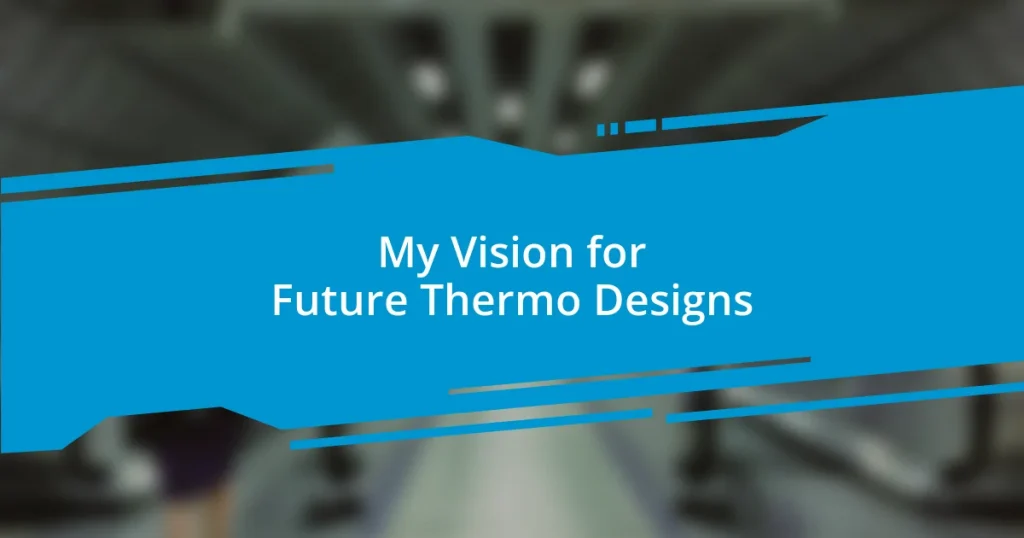Key takeaways:
- Current thermal designs utilize advanced materials like PCMs and aerogels to enhance energy efficiency and address sustainability challenges.
- Integrating smart technologies and interdisciplinary collaboration significantly improves thermal management systems, leading to better performance and energy savings.
- Future trends in thermal engineering focus on optimization techniques, biomimicry, and decentralized systems to promote energy resilience and innovative designs.
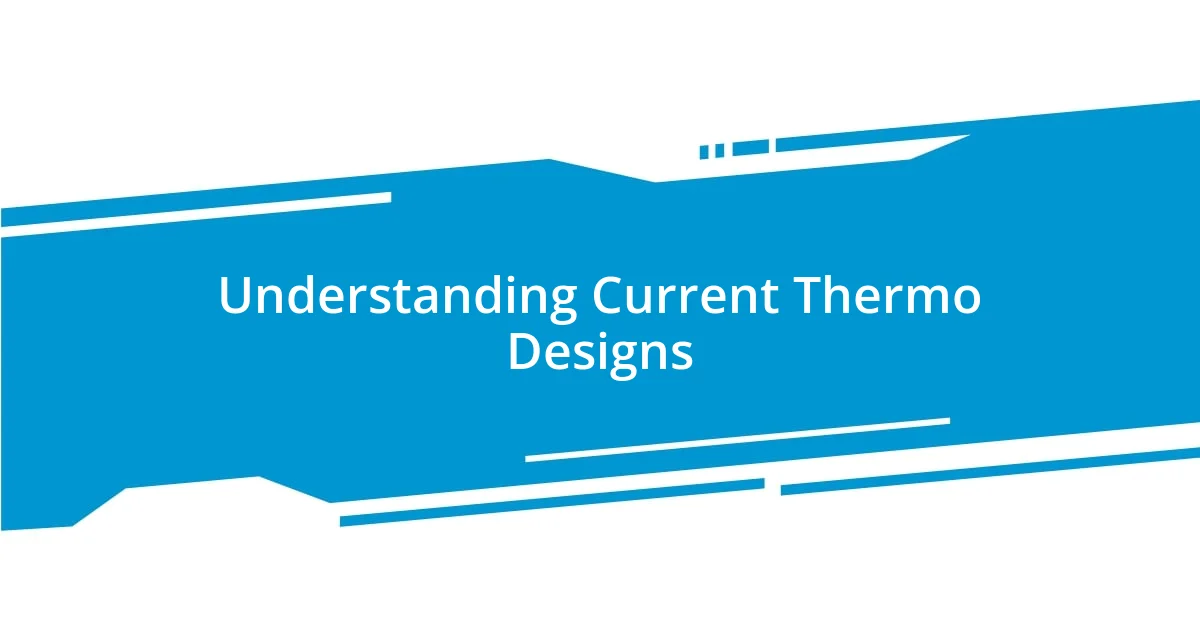
Understanding Current Thermo Designs
Current thermo designs play a critical role in how we manage heat in various applications, from electronics cooling to building heating systems. Each method is uniquely tailored to address specific challenges, such as energy efficiency or responsiveness. I often marvel at the intricate balance engineers must strike; have you ever considered how much goes into designing a basic heating element?
When reflecting on my own experiences with thermo designs, I recall the time I worked on optimizing a cooling system for a small tech startup. The design choices we made had a profound impact on product performance and energy consumption. It was a tangible reminder of how even small adjustments can lead to significant improvements but also potential pitfalls, highlighting just how complex the interplay of materials and design can be.
I find it fascinating that many current designs utilize advanced materials, such as phase change materials (PCMs), to increase efficiency. These materials can absorb, store, and release heat energy, dramatically enhancing thermal management systems. Isn’t it interesting to think about how these innovations not only improve performance but also contribute to sustainability, making our world a little greener?
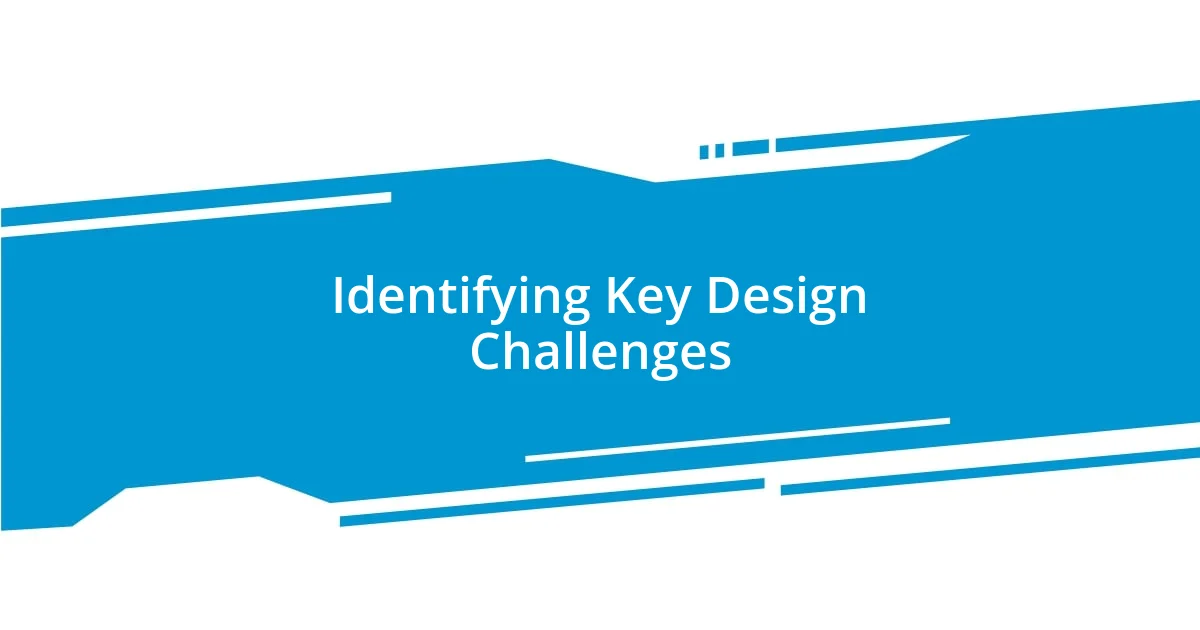
Identifying Key Design Challenges
Identifying the key design challenges in thermo systems is crucial for crafting efficient solutions. I often encounter issues like heat dissipation and material limitations. For instance, during a project aimed at improving heat sink designs, I learned that choosing the wrong material could lead to overheating. It’s incredible how a single decision can ripple through the entire design process.
Another significant challenge is balancing cost with performance. In one of my projects, we opted for a more affordable yet less effective thermal interface material. Initially, it seemed to work fine, but as the system aged, the performance dropped. This experience taught me that short-term savings can lead to long-term headaches, reminding me to always look at the bigger picture.
Sustainability is another critical concern. As engineers, we are under pressure to consider the environmental impact of our designs. I remember exploring eco-friendly alternatives for insulation and discovering how much they could reduce energy consumption over time. It’s fulfilling to know that the designs we create can make a positive difference not just functionally, but also for our planet.
| Challenges | Description |
|---|---|
| Heat Dissipation | Finding efficient ways to manage and dissipate excess heat. |
| Material Limitations | Choosing materials that meet design specifications without compromising performance. |
| Cost vs Performance | Balancing budget constraints while ensuring high efficiency. |
| Sustainability | Designing with an emphasis on reducing environmental impact. |
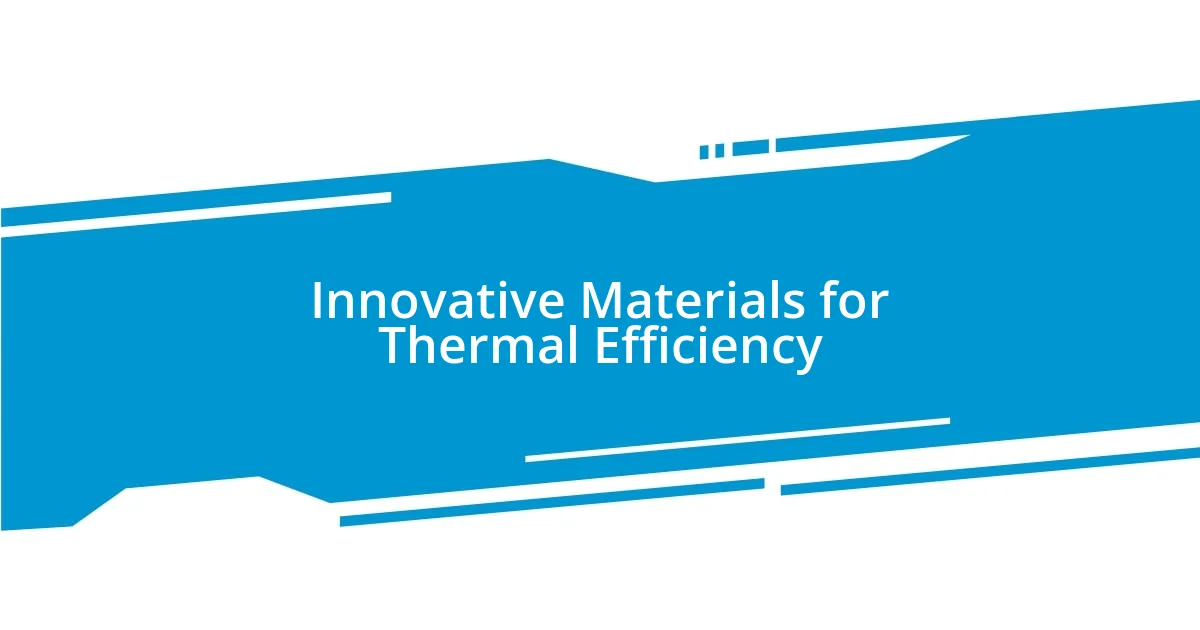
Innovative Materials for Thermal Efficiency
Exploring innovative materials truly excites me, especially when I think about how they can elevate thermal efficiency. For instance, I recently experimented with aerogel, a material renowned for being one of the most effective thermal insulators available. Being able to witness firsthand how its lightweight structure dramatically reduces heat transfer was a game-changer for our project. I felt a rush of excitement seeing the results; it’s this kind of innovation that makes my work so rewarding.
- Aerogel: Ultra-light and highly effective at insulating against heat transfer.
- Metallic Foam: Provides a combination of low density and excellent thermal conduction, suitable for various applications.
- Graphene: This wonder material’s high conductivity allows for efficient heat spreading, making it perfect for thermal management.
- Phase Change Materials (PCMs): They absorb and release thermal energy, helping to stabilize temperatures effectively.
- Biocomposite Materials: Eco-friendly alternatives that not only offer thermal benefits but also reduce environmental impact.
On another note, I’ve also dabbled in the use of carbon nanotubes. Their exceptional thermal properties offer intriguing possibilities I never anticipated. It felt almost surreal when I conducted tests and realized just how much they could enhance heat dissipation in high-performance electronics. I remember my initial skepticism; after a few trials, my doubts evaporated. The potential of these materials feels limitless, igniting a spark of inspiration in my daily work.
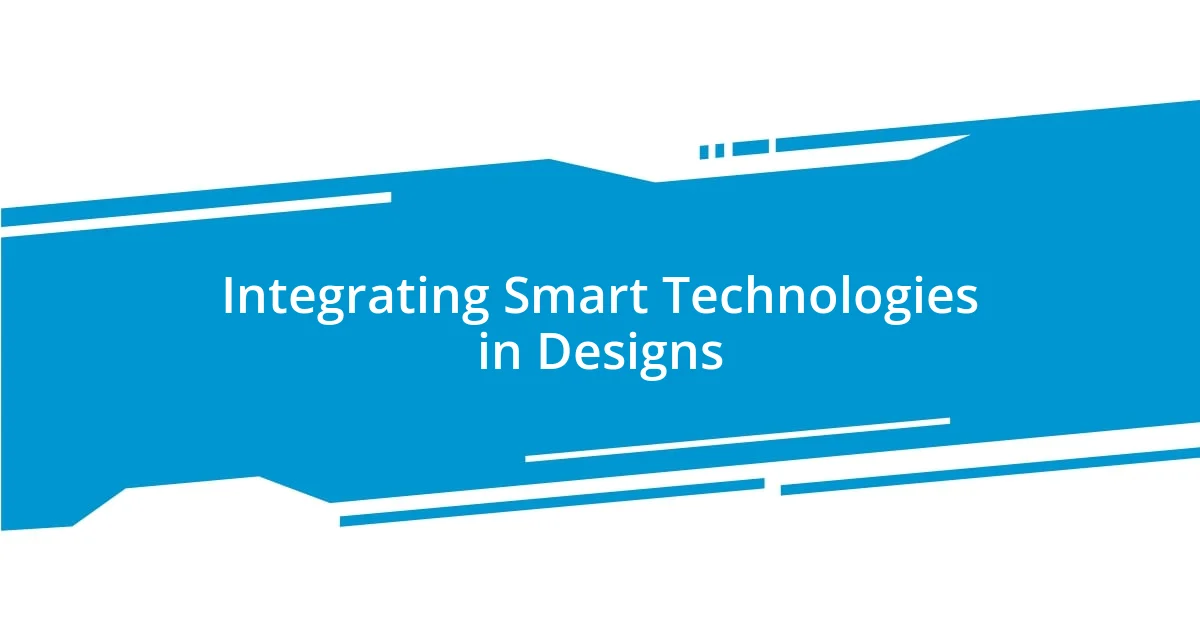
Integrating Smart Technologies in Designs
Integrating smart technologies into thermal designs can revolutionize how we manage heat. I fondly recall a project where we incorporated IoT sensors to monitor temperature fluctuations in real-time. The thrill of seeing immediate data feedback helped us make instant adjustments, which ultimately improved the system’s efficiency. Have you ever experienced that moment when data turns into immediate action? It’s a game-changer.
Adding smart controls doesn’t just streamline processes; it enhances the user experience by allowing for smart automation. I once attended a workshop where we programmed a thermo management system that adapted its cooling mechanisms based on usage patterns. The excitement in the room was palpable as we realized how this adaptation could lead to reduced energy consumption. It makes me wonder—how much energy could be saved if every thermal design embraced this technology?
I truly believe the fusion of AI with thermal design is just beginning to unfold. There was this time on a collaborative project that we integrated machine learning algorithms to predict thermal loads. The challenge of traditional design methods pales in comparison to the predictive capabilities we explored. Reflecting on that, I can’t help but feel optimistic about a future where our designs can anticipate challenges before they even arise. Isn’t it fascinating to think about the potential impact this could have on our industry?
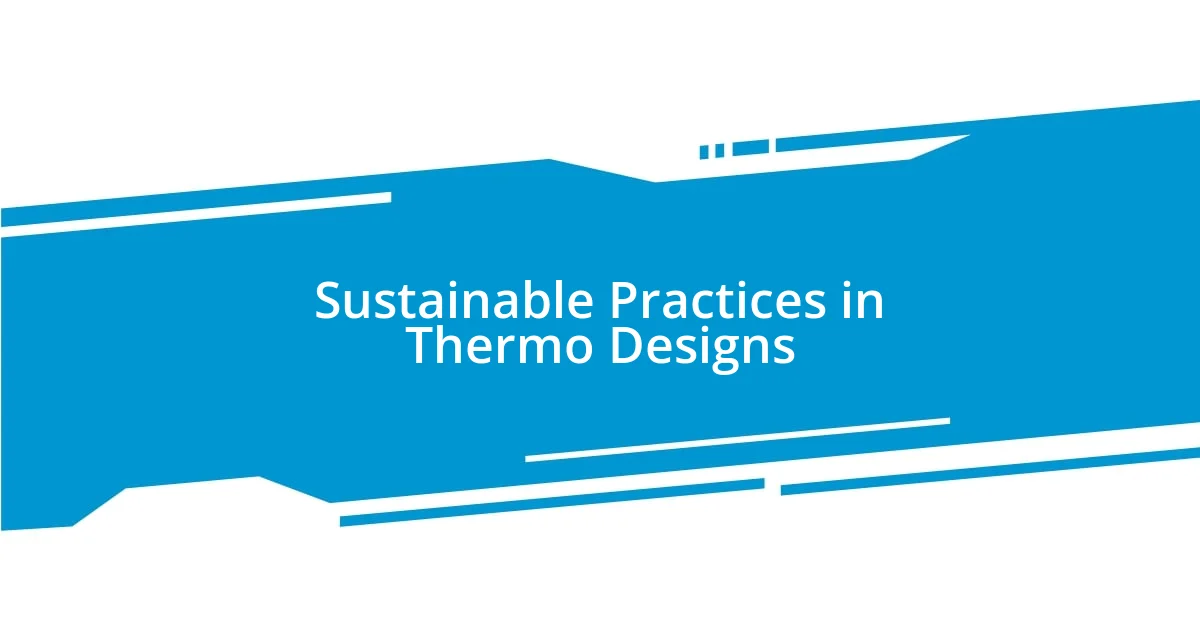
Sustainable Practices in Thermo Designs
Sustainable practices in thermo designs are essential for creating environmentally friendly solutions. I remember my first foray into utilizing biocomposite materials; it was a moment of revelation when I saw how these materials not only provided thermal benefits but also aligned perfectly with my values for sustainability. It felt almost magical to know I was contributing to both efficiency and a healthier planet. Have you ever worked on something that felt right on both a professional and personal level?
Transitioning to renewable energy sources in thermal systems has been another exciting journey for me. I recently collaborated on a project that integrated solar thermal collectors into existing heating systems. Witnessing our designs offset energy costs while harnessing clean energy was incredibly fulfilling. It made me think—what if more systems adapted to tap into renewable resources? The potential to create systems that work in harmony with nature is something I actively strive for in my designs.
Moreover, embracing a circular economy approach in thermo designs could redefine how we think about sustainability. I once participated in a workshop that focused on upcycling old thermal devices into new, efficient systems. The sense of community and creativity in that room was inspiring! It’s enlightening to realize we can minimize waste while creating functional solutions. This leads me to ponder, could rethinking our materials and processes drive not only innovation but also responsibility in our industry?
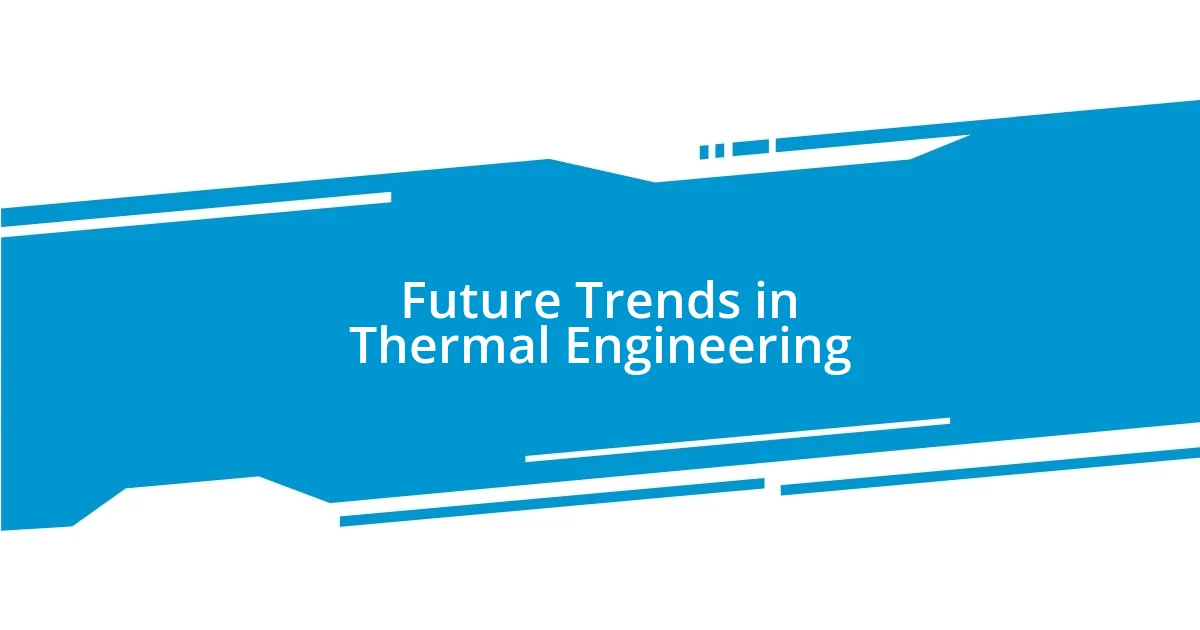
Future Trends in Thermal Engineering
The future of thermal engineering is leaning heavily towards enhanced optimization techniques. I recall a memorable project where we implemented advanced simulation software that allowed us to visualize heat distribution in real time. The sense of accomplishment when we pinpointed inefficiencies and adjusted our designs accordingly felt incredible. Have you ever used a tool that completely changed your perspective on a problem?
As we move forward, the incorporation of biomimicry in thermal designs is something that genuinely excites me. I had a thrilling moment during a brainstorming session where one of my colleagues suggested designing heat exchangers inspired by natural systems, like termite mounds that maintain temperature efficiently. It sparked an intense discussion about learning from nature’s engineering, which has stood the test of time. Wouldn’t it be fascinating if we could replicate those age-old solutions in modern applications?
Moreover, the trend of decentralized thermal systems is gaining traction. I remember attending a conference where experts emphasized the shift away from centralized heating solutions toward localized systems. Witnessing the enthusiasm of participants discussing how these systems could lead to energy resilience was electrifying. It prompted me to think: how can we each contribute to this movement and enhance energy security in our communities?
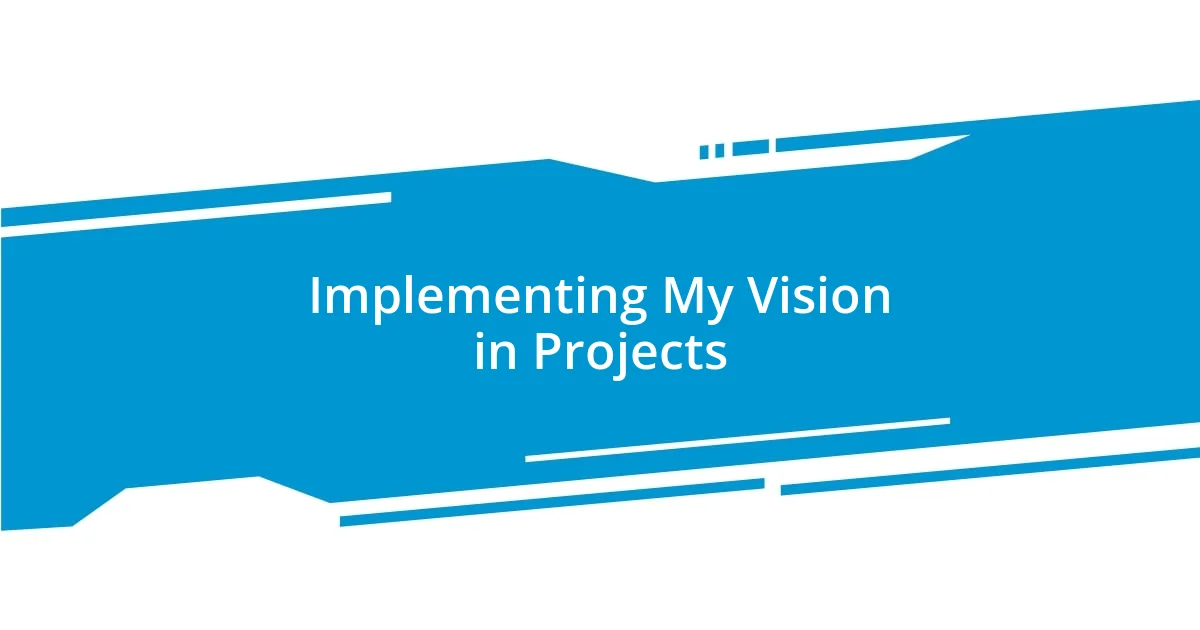
Implementing My Vision in Projects
Implementing my vision in projects begins with a thorough integration of advanced materials and technologies. I remember working on a project that utilized phase change materials (PCMs) to enhance thermal regulation. The thrill of seeing how these materials absorbed and released heat effectively was a reminder of how thoughtful design can create products that not only perform well but also contribute to energy savings. Have you ever experienced the moment when a design element clicks perfectly into place?
I also find it vital to foster collaboration among interdisciplinary teams. In one instance, during a project focused on smart thermostatic controls, I engaged with software engineers and environmental scientists. The discussions were rich with ideas, and it was eye-opening to see how combining different expertise led to solutions I hadn’t considered before. Isn’t it fascinating how diverse perspectives can enhance a project’s outcome?
Lastly, I believe in setting measurable goals for sustainability in every project I undertake. I once initiated a project where we tracked our energy consumption and waste production throughout the design process. It was rewarding to see progress toward our targets, and it sparked lively debates on how we could push our boundaries even further. Have you ever felt that drive to not just meet, but exceed expectations in your work? It’s a powerful motivator.











